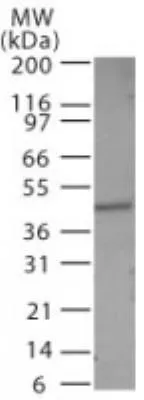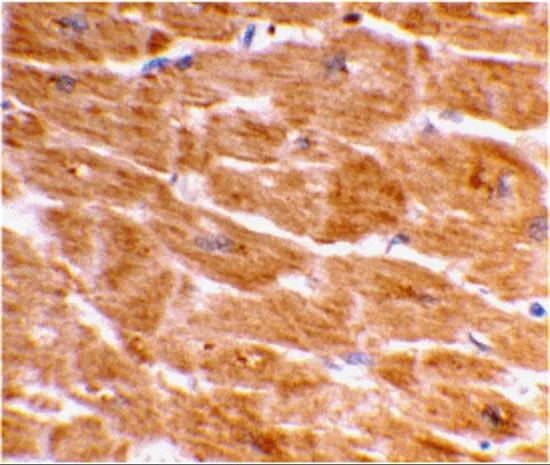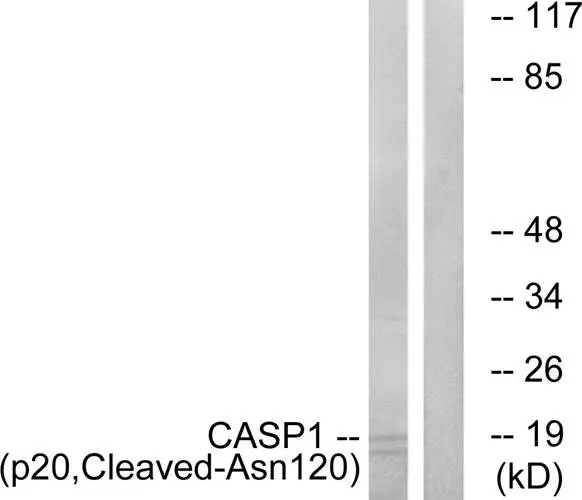Caspase 1 antibody [N1N3]
GTX101322
ApplicationsImmunoFluorescence, Western Blot, ImmunoCytoChemistry, ImmunoHistoChemistry, ImmunoHistoChemistry Paraffin
Product group Antibodies
TargetCASP1
Overview
- SupplierGeneTex
- Product NameCaspase 1 antibody [N1N3]
- Delivery Days Customer9
- Application Supplier NoteWB: 1:500-1:10000. ICC/IF: 1:100-1:1000. IHC-P: 1:100-1:1000. *Optimal dilutions/concentrations should be determined by the researcher.Not tested in other applications.
- ApplicationsImmunoFluorescence, Western Blot, ImmunoCytoChemistry, ImmunoHistoChemistry, ImmunoHistoChemistry Paraffin
- CertificationResearch Use Only
- ClonalityPolyclonal
- Concentration1.08 mg/ml
- ConjugateUnconjugated
- Gene ID834
- Target nameCASP1
- Target descriptioncaspase 1
- Target synonymsICE, IL1BC, P45, caspase-1, IL-1 beta-converting enzyme, IL1B-convertase, caspase 1, apoptosis-related cysteine peptidase, interleukin 1, beta, convertase, interleukin 1-B converting enzyme
- HostRabbit
- IsotypeIgG
- Protein IDP29466
- Protein NameCaspase-1
- Scientific DescriptionThis gene encodes a protein which is a member of the cysteine-aspartic acid protease (caspase) family. Sequential activation of caspases plays a central role in the execution-phase of cell apoptosis. Caspases exist as inactive proenzymes which undergo proteolytic processing at conserved aspartic residues to produce 2 subunits, large and small, that dimerize to form the active enzyme. This gene was identified by its ability to proteolytically cleave and activate the inactive precursor of interleukin-1, a cytokine involved in the processes such as inflammation, septic shock, and wound healing. This gene has been shown to induce cell apoptosis and may function in various developmental stages. Studies of a similar gene in mouse suggest a role in the pathogenesis of Huntington disease. Alternative splicing of this gene results in five transcript variants encoding distinct isoforms. [provided by RefSeq]
- Storage Instruction-20°C or -80°C,2°C to 8°C
- UNSPSC12352203
References
- Feng M, Wei S, Zhang S, et al. Anti-Inflammation and Anti-Pyroptosis Activities of Mangiferin via Suppressing NF-κB/NLRP3/GSDMD Signaling Cascades. Int J Mol Sci. 2022,23(17). doi: 10.3390/ijms231710124Read this paper
- Hosoya T, Uchida S, Shibata S, et al. Xanthine Oxidoreductase Inhibitors Suppress the Onset of Exercise-Induced AKI in High HPRT Activity Urat1-Uox Double Knockout Mice. J Am Soc Nephrol. 2022,33(2):326-341. doi: 10.1681/ASN.2021050616Read this paper
- Zhang C, Chen M, Chi Z. Cytokine secretion and pyroptosis of cholesteatoma keratinocytes mediated by AIM2 inflammasomes in response to cytoplasmic DNA. Mol Med Rep. 2021,23(5):pii: 344. doi: 10.3892/mmr.2021.11983.Read this paper
- Wu CY, Hua KF, Yang SR, et al. Tris DBA ameliorates IgA nephropathy by blunting the activating signal of NLRP3 inflammasome through SIRT1- and SIRT3-mediated autophagy induction. J Cell Mol Med. 2020,24(23):13609-13622. doi: 10.1111/jcmm.15663Read this paper
- Yang JC, Yang HC, Shun CT, et al. Catechins and Sialic Acid Attenuate Helicobacter pylori-Triggered Epithelial Caspase-1 Activity and Eradicate Helicobacter pylori Infection. Evid Based Complement Alternat Med. 2013,2013:248585. doi: 10.1155/2013/248585Read this paper






